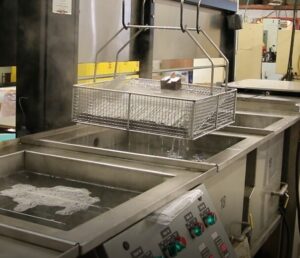
Understanding how to passivate stainless steel is an essential step employed by fabricators to ensure the long-term performance and durability of stainless steel parts and components. As a post-fabrication finishing process, passivation enhances and optimizes the natural corrosion resistance of stainless steel without changing the fundamental properties of the material. To passivate stainless steel, the metal’s surface is treated with an acid solution that reacts with oxygen to form an oxide layer that protects the underlying metal surface from corrosion.
The Basics of Stainless Steel Passivation
One common misconception about stainless steel is that it is entirely stain-proof. Stainless steel comes in many grades and types which are determined by the combination of alloying elements used in its fabrication. That said, what makes steel stainless is, in a word, the addition of chrome. Steel, the alloy of iron and carbon, becomes stainless when alloyed with a minimum of 10.5 percent chromium. Though there are other common alloys used to produce stainless steel, like nickel and molybdenum, it is chromium that produces a thin, “passive” layer of oxide on the material’s surface that inhibits corrosion. If iron particles or other substances have become embedded in the surface during fabrication or polishing operations, they must be removed. Otherwise, these minute particles may promote discoloration, rusting, or even pitting.
Though chromium makes steel stainless, post-fabrication, it is not unusual for stainless steel to be corrupted by any combination of various mechanical, industrial, and environmental processes. Welding, cutting, or grinding, for example, can lead to the exposure of the underlying steel, which leaves it prone to rusting. Passivation then, is the final step used by fabricators to clear impurities from the surface of stainless steel and create a protective oxide layer.
Fabricators turn to certain passivation techniques to make the material “passive” to the environment. For stainless steel to be rendered passive it must become “unreactive” to atmospheric conditions by having the free iron and other impurities removed from the material’s surface that would otherwise lead to corrosion. Passivation is a controlled process designed to accelerate the natural formation of the protective oxide layer.
Understanding Stainless Steel Passivation Do’s and Don’ts
Fabricators follow several important “do’s and don’ts” to ensure effective passivation:
Stainless Steel Passivation “Dos”
The “do’s” of passivization begin with thoroughly cleaning the stainless steel surface to remove any residual dirt, grease, oil, or other contaminants. Once the surface has been cleaned it is rinsed with clean water to remove any residual cleaning agents. The stainless steel can then be immersed in a passivation bath. The bath typically contains a solution of nitric acid or citric acid. The concentration and temperature of the solution should comply with recommended industry standards. For the immersion time, the stainless steel should remain in the bath for as long as it takes for the solution to remove any free iron or other impurities from the surface to ensure the formation of the protective chromium oxide layer. After the bath is completed, thoroughly rinse the stainless steel components with clean water to remove any residual passivation solution and then dry.
Stainless Steel Passivation “Don’ts”
Avoiding the “don’ts” of passivation will help ensure the material’s corrosion resistance is optimized. Do not mix different grades of stainless steel in the same passivation bath, as this may lead to contamination, which could reduce the effectiveness of the passivation process. Also, be sure that the tools and equipment used in the passivation are clean and free from contamination so as not to introduce impurities to the stainless steel. Do not keep stainless steel in the passivation solution too long. Overexposure can lead to over-etching and compromise the corrosion resistance of the material. Finally, do not avoid further corrosion and contamination, and do not forget to rinse the residual passivation solution from the material.
Contact the Stainless Steel Experts at Eagle Stainless
To learn more on how to passivate stainless steel and how it can improve the corrosion-resistant properties of the material for your project, contact the experts at Eagle Stainless Tube & Fabrication Inc., today. With a dedication to excellence, we are committed to quality, reliability, and customer satisfaction, and can help your company with your fabrication needs.



